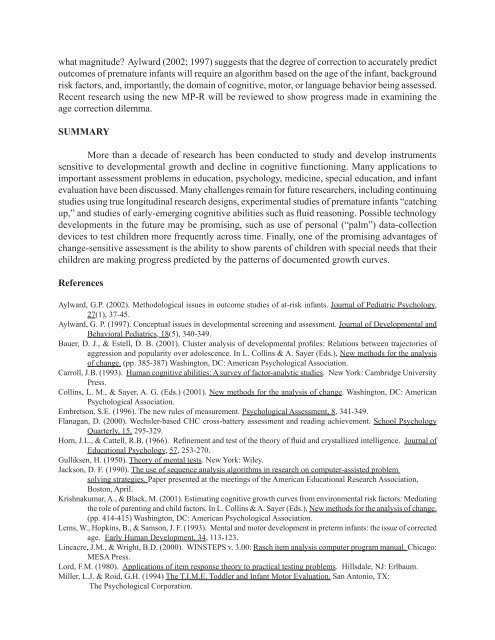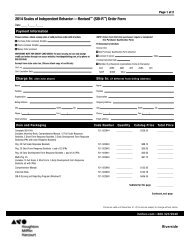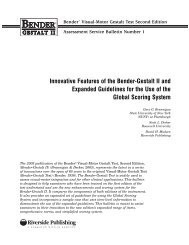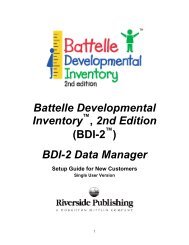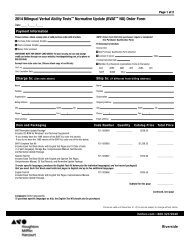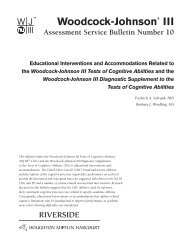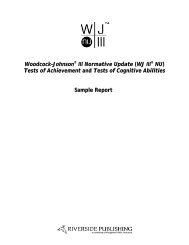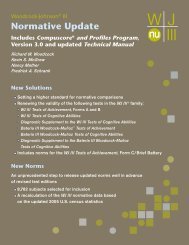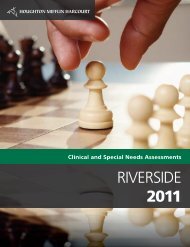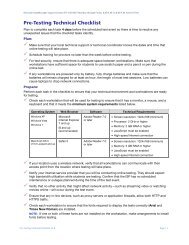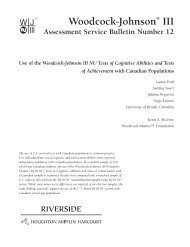Quality of Performance and Change-Sensitive ... - Nelson Education
Quality of Performance and Change-Sensitive ... - Nelson Education
Quality of Performance and Change-Sensitive ... - Nelson Education
You also want an ePaper? Increase the reach of your titles
YUMPU automatically turns print PDFs into web optimized ePapers that Google loves.
what magnitude? Aylward (2002; 1997) suggests that the degree <strong>of</strong> correction to accurately predictoutcomes <strong>of</strong> premature infants will require an algorithm based on the age <strong>of</strong> the infant, backgroundrisk factors, <strong>and</strong>, importantly, the domain <strong>of</strong> cognitive, motor, or language behavior being assessed.Recent research using the new MP-R will be reviewed to show progress made in examining theage correction dilemma.SUMMARYMore than a decade <strong>of</strong> research has been conducted to study <strong>and</strong> develop instrumentssensitive to developmental growth <strong>and</strong> decline in cognitive functioning. Many applications toimportant assessment problems in education, psychology, medicine, special education, <strong>and</strong> infantevaluation have been discussed. Many challenges remain for future researchers, including continuingstudies using true longitudinal research designs, experimental studies <strong>of</strong> premature infants “catchingup,” <strong>and</strong> studies <strong>of</strong> early-emerging cognitive abilities such as fluid reasoning. Possible technologydevelopments in the future may be promising, such as use <strong>of</strong> personal (“palm”) data-collectiondevices to test children more frequently across time. Finally, one <strong>of</strong> the promising advantages <strong>of</strong>change-sensitive assessment is the ability to show parents <strong>of</strong> children with special needs that theirchildren are making progress predicted by the patterns <strong>of</strong> documented growth curves.ReferencesAylward, G.P. (2002). Methodological issues in outcome studies <strong>of</strong> at-risk infants. Journal <strong>of</strong> Pediatric Psychology,27(1), 37-45.Aylward, G. P. (1997). Conceptual issues in developmental screening <strong>and</strong> assessment. Journal <strong>of</strong> Developmental <strong>and</strong>Behavioral Pediatrics, 18(5), 340-349.Bauer, D. J., & Estell, D. B. (2001). Cluster analysis <strong>of</strong> developmental pr<strong>of</strong>iles: Relations between trajectories <strong>of</strong>aggression <strong>and</strong> popularity over adolescence. In L. Collins & A. Sayer (Eds.), New methods for the analysis<strong>of</strong> change. (pp. 385-387) Washington, DC: American Psychological Association.Carroll, J.B. (1993). Human cognitive abilities: A survey <strong>of</strong> factor-analytic studies. New York: Cambridge UniversityPress.Collins, L. M., & Sayer, A. G. (Eds.) (2001). New methods for the analysis <strong>of</strong> change. Washington, DC: AmericanPsychological Association.Embretson, S.E. (1996). The new rules <strong>of</strong> measurement. Psychological Assessment, 8, 341-349.Flanagan, D. (2000). Wechsler-based CHC cross-battery assessment <strong>and</strong> reading achievement. School PsychologyQuarterly, 15, 295-329.Horn, J.L., & Cattell, R.B. (1966). Refinement <strong>and</strong> test <strong>of</strong> the theory <strong>of</strong> fluid <strong>and</strong> crystallized intelligence. Journal <strong>of</strong><strong>Education</strong>al Psychology, 57, 253-270.Gulliksen, H. (1950). Theory <strong>of</strong> mental tests. New York: Wiley.Jackson, D. F. (1990). The use <strong>of</strong> sequence analysis algorithms in research on computer-assisted problemsolving strategies. Paper presented at the meetings <strong>of</strong> the American <strong>Education</strong>al Research Association,Boston, April.Krishnakumar, A., & Black, M. (2001). Estimating cognitive growth curves from environmental risk factors: Mediatingthe role <strong>of</strong> parenting <strong>and</strong> child factors. In L. Collins & A. Sayer (Eds.), New methods for the analysis <strong>of</strong> change.(pp. 414-415) Washington, DC: American Psychological Association.Lems, W., Hopkins, B., & Samson, J. F. (1993). Mental <strong>and</strong> motor development in preterm infants: the issue <strong>of</strong> correctedage. Early Human Development, 34, 113-123.Lincacre, J.M., & Wright, B.D. (2000). WINSTEPS v. 3.00: Rasch item analysis computer program manual. Chicago:MESA Press.Lord, F.M. (1980). Applications <strong>of</strong> item response theory to practical testing problems. Hillsdale, NJ: Erlbaum.Miller, L.J. & Roid, G.H. (1994) The T.I.M.E. Toddler <strong>and</strong> Infant Motor Evaluation. San Antonio, TX:The Psychological Corporation.


